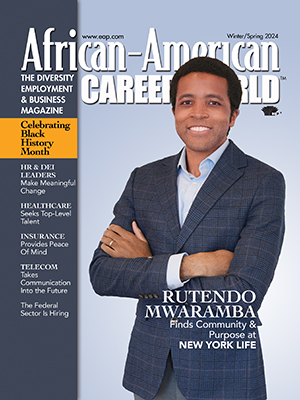| |

African-American Career World Magazine, launched in 2001, is the recruitment link between students and professionals who are African American and the employers that seek to hire them.
The publication includes career strategies, industry trends, and role-model profiles that target the African-American community.
This magazine reaches students, graduate students and professionals at their home addresses.
If you are an African-American college student or professional, African-American Career World is available to you FREE!

|
|
 African-American
African-American
Career World
» Featured Articles
» Subscription Information
» Reader Survey
» Companies Actively Recruiting

HOW TO WIN AT NETWORKING
Patti Verbanas
NETWORKING IS A POWERFUL TOOL TO FURTHERING YOUR GOALS – IF YOU KNOW WHAT YOU’RE DOING, SAYS A RUTGERS COMMUNICATION EXPERT
The New Year often brings with it aspirations of professional improvement: Find that dream job, grow or start a business, make new connections. Networking is key to achieving these goals, but approaching strangers and striking up a conversation can be daunting.
Today, many bypass face-to-face encounters and turn only to social media – which can be a big mistake, says Michael Goldberg, who has taught public speaking and networking skills at Rutgers School of Communication and Information for the past decade. An amateur boxer, Goldberg uses metaphors from the ring to convey points. “Networking, like boxing, is all about the connection – the physical connection,” he says.
Goldberg, who also guides professionals through his consulting firm, Knockout Networking (knockoutneworking.com), addresses ways to overcome anxiety and connect with people more effectively.
The real goal of networking
“Networking is about forging a reciprocal relationship in which you seek to meet people you can learn from and offer yourself as a resource,” says Goldberg. “You’re selling them on the fact that you’re social, nice, open, giving and smart. You’re looking to make a connection with people who – if they like you – ideally will want to help you, too.”
The most difficult aspect of the networking process
“Millennials – students in particular – have difficultly finding people to network with and when they do, they do not know how to start the conversation and make it meaningful,” says Goldberg. “In my consulting business, I find that my clients – brokers, financial advisers, agents, and sales professionals – do not have a clear view of what they are seeking to achieve from the relationship. They try to promote and sell a product rather than focusing on the collaborative quid pro quo that is networking.”
Find opportunities for networking
“Professionals in established industries can attend networking events, trade shows, conferences, and association meetings,” Goldberg explains. “Current students, recent graduates, and job seekers need to forge connections in the industry they wish to join. They can do this by participating in events given by their school’s alumni associations or professional associations in the field that they wish to enter. At industry or alumni events, people expect networking and are receptive to it.”
Impact of social media on how people network
“Although social media is a powerful tool, in many ways it prevents people from making ‘real’ connections, which minimizes the chance to forge important relationships,” he explains. “Business people and job seekers often view social media as a substitute for actually meeting people at networking events, alumni meetings, and professional associations and engaging in helpful conversations – which have a greater chance of leading to meaningful connections.”
The most effective approach to networking
“People network for five reasons: to land a job, do business, learn something, be social, or solve a specific problem,” Goldberg observes. “You first must understand what you want to achieve. Next, you should identify where it is best to network, what specifically you should say, and to whom. If you know your endgame, it makes answering these other questions easier.”
The difference between the “PEEC Statement” (created by Goldberg) from an “elevator speech”
Unlike an elevator speech, PEEC is not a sales pitch, says Goldberg. With PEEC, “you are setting yourself up as an expert in your field as much as you are asking for assistance,” he continues. “PEEC is a positioning statement of four bullet points: profession, expertise, environment, and call to action. These points can help guide you to introduce yourself and promote yourself as a resource in 30 seconds.
“First, you describe what you do and the areas in which you have the most knowledge. Your environment is your target market or the people who you serve. You end with a specific call to action: What do you want to accomplish? Is it finding a job in a specific company? Expanding your business in a certain direction? Finding out the name and title of a person you would like to be introduced to?”
How to start a conversation with a total stranger
“Start by introducing yourself,” Goldberg advises. ‘It’s nice to meet you. I’m a student at Rutgers University majoring in human resources management.’ Then state specifically what you want: ‘I would like to learn about some of your new initiatives. Would you be open to speaking with me next week?’
“Have follow-up questions prepared that will help you learn more about their world and offer suggestions as to how you might be able to help them achieve the goals they describe. Most of the time, the conversation will turn to how they can help you.”
 » Feedback for the Editor
» Feedback for the Editor
» Request Article Copy
|
|